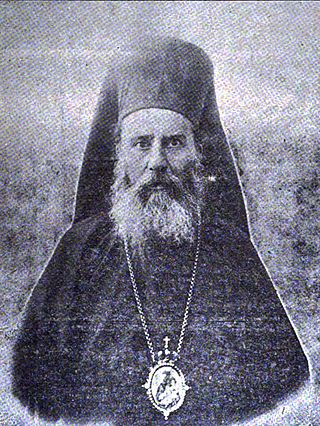The Patriarch of Antioch is a traditional title held by the bishop of Antioch. As the traditional "overseer" of the first gentile Christian community, the position has been of prime importance in Pauline Christianity from its earliest period. This diocese is one of the few for which the names of its bishops from the apostolic beginnings have been preserved. Today five churches use the title of patriarch of Antioch: one Eastern Orthodox ; one Oriental Orthodox ; and three Eastern Catholic.
Macarius is a Latinized form of the old Greek given name Makários (Μακάριος), meaning "happy, fortunate, blessed"; compare the Latin beatus and felix. Ancient Greeks applied the epithet Makarios to the gods.

The Melkite Greek Catholic Church, or Melkite Byzantine Catholic Church, is an Eastern Catholic church in full communion with the Holy See as part of the worldwide Catholic Church. Its chief pastor is Patriarch Youssef Absi, headquartered at the Cathedral of Our Lady of the Dormition in Damascus, Syria. The Melkites, who are Byzantine Rite Catholics, trace their history to the early Christians of Antioch, formerly part of Syria and now in Turkey, of the 1st century AD, where Christianity was introduced by Saint Peter.

The Melkite Catholic Patriarchate of Antioch is the only actual residential Patriarchate of the Melkite Greek Catholic Church. It was formed in 1724 when a portion of the Orthodox Church of Antioch went into communion with Rome, becoming an Eastern Catholic Church, while the rest of the ancient Patriarchate continues in full communion with the rest of the Eastern Orthodox Church.
Joseph Elias Tawil was a Syrian prelate who served as Eparch of Newton in the Melkite Greek Catholic Church from 1970 to 1989. He is remembered for his participation in the Second Vatican Council, expanding the Melkite Church in the United States, and articulating the unique role of the Eastern Catholic Churches in his 1970 pastoral letter, The Courage to Be Ourselves.
Patriarch Cyril VI Tanas, also known as Cyril VI of Antioch, became the first Patriarch of Antioch and All the East, and Alexandria and Jerusalem of the Melkite Greek Catholic Church following the schism of the Greek Orthodox Patriarchate of Antioch in 1724. Cyril re-established full communion with the Catholic Church.

Patriarch Gregory II Youssef, also known as Gregory II Hanna Youssef-Sayour, was Patriarch of the Melkite Greek Catholic Church from 1864 to 1897. Gregory expanded and modernized the church and its institutions and participated in the First Vatican Council, where he championed the rights of the Eastern Catholic Churches.

Peter IV Barakat Géraigiry was patriarch of the Melkite Greek Catholic Church from 1898 until 1902.
Clement Michael Bahouth was patriarch of the Melkite Catholic Church from 1856 until his resignation in 1864.
The Basilian Order of the Most Holy Saviour abbreviated BS, also known as the Basilian Salvatorian Order, is an Eastern Catholic monastic order of Pontifical Right for men of the Greek-Melkite Catholic Church. The name derives from its motherhouse, the Holy Saviour Monastery, at Joun in Chouf near Sidon, Lebanon.
Ignatius V Moussa Qattan, was patriarch of the Melkite Greek Catholic Church from 1816 until 1833.
Theodosius V Dahan (1698–1788) was Patriarch of the Melkite Greek Catholic Church from 1761 to 1788.
Athanasius V Gabriel Matar was Patriarch of the Melkite Greek Catholic Church for a few months in 1813.
Cyril VII Francis Siaj was Patriarch of the Melkite Greek Catholic Church from 1794 to 1796.
Athanasius IV Ignace Michael Jawhar was Patriarch of the Melkite Greek Catholic Church from 1788 to 1794. He previously claimed to be patriarch from 1759 to 1764 and from 1765 to 1768.
Patriarch Athanasius III Dabbas (1647–1724), sometimes known also as Athanasius IV, was the last Patriarch of Antioch before the final split of 1724 which divided the Melkite Church between the Melkite Greek Catholic Church and the Greek Orthodox Church of Antioch. He was shortly, from 1705 to 1707, also regent Archbishop of Cyprus, where he is known as Athanasios II.
Patriarch Constantine Cyril V Zaim, sometimes known also as Cyril III, was Patriarch of Antioch.

Jeremias III was Ecumenical Patriarch of Constantinople twice, in 1716–1726 and 1732–1733.
The Synod of Qarqafe was a council of the Melkite Greek Catholic Church held in 1806. The synod adapted and ratified propositions of the 1786 Synod of Pistoia. It would be formally condemned in 1835 by Pope Gregory XVI in the bull Melchitarum Catholicorum Synodus.
This page is based on this
Wikipedia article Text is available under the
CC BY-SA 4.0 license; additional terms may apply.
Images, videos and audio are available under their respective licenses.




